Full Guide: Tokyo, Japan
Tokyo is a city that just gets it - and where the art of hospitality truly can be felt.
Every time we travel, we return home with a new perspective and a little bit changed for it. When it comes to Tokyo, this city has left a lasting imprint in my heart forever. My first trip was in 2009 for a three-month residency (a post for another day), and it was a life-changing experience— I literally had dreams about returning, walking the streets of Shibuya. Fifteen years later, the time finally came to make a trip back to the “Land of the Rising Sun” and reconnect with this special place. Sharing this guide with you all brings me such joy and feels extra meaningful, like sharing a piece of my heart. I truly hope you all get the opportunity to visit this incredible, eye-opening part of the world.
What to See & Do
Historic Sights & Landmarks
Tokyo Tower: A recognizable symbol of the city (even with its own emoji), Tokyo Tower is a post-war symbol of Japan’s economic resurgence and was inspired by the Eiffel Tower. On a clear day, you can get amazing views of Mt. Fuji.
Meiji Shrine (Meiji Jingu): With a dramatic entrance featuring a stately torii gate near the Harajuku station, this shrine is a short walk through a quiet forest dedicated to Emperor Meiji and Empress Shoken.
Senso-ji Temple: Tokyo’s oldest and most famous Buddhist temple in Asakusa, featuring the iconic Kaminarimon (Thunder Gate) and Nakamise shopping street filled with lots of traditional snacks and souvenirs. Kind of like an outdoor food hall. Just don’t walk and eat - that’s frowned upon in Japan. Stop and savor the moment.
Imperial Palace & East Gardens: While the palace itself is not open to the public, the surrounding gardens offer a glimpse into Japan’s imperial history with beautiful landscaping and remnants of Edo Castle.
Nezu Shrine: A lesser-known but stunning shrine with a series of vermillion torii gates and tranquil gardens, it has an Azalea garden that is worth visiting in spring.
Shibuya Crossing: Not quite a landmark, but definitely worth seeing as it’s become iconic to Tokyo, Shibuya Crossing is supposedly the busiest pedestrian crossing in the world.
Arts & Culture
Mori Art Museum: A contemporary art museum in Roppongi Hills that hosts rotating exhibitions featuring Japanese and international artists, plus breathtaking city views from the observation deck.
teamLab Planets: While immersive digital art museums have become trendy for IG pics, teamLab is one of the originals and gives you a truly multisensory experience with some really impressive art.
They also have a second one that opened more recently, teamLab Borderless, which is in the city’s new Azabudai Hills luxury shopping district. We enjoyed them both equally, but if you can only choose one, go with teamLab Planets.
Nezu Museum: A hidden gem in Minami-Aoyama showcasing a private collection of pre-modern Japanese and East Asian art, with an expansive zen garden that feels like a secret oasis.
Kabuki-za Theatre: The best place to experience traditional Kabuki performances with elaborate costumes and dramatic storytelling. Shorter, tourist-friendly ticket options are also available.
Sumo: If you are up for an early morning and want to watch a sumo practice in Tokyo, there is a set schedule that you have to check here in order to know whether a practice is taking place. You can also book a tour with a guide.
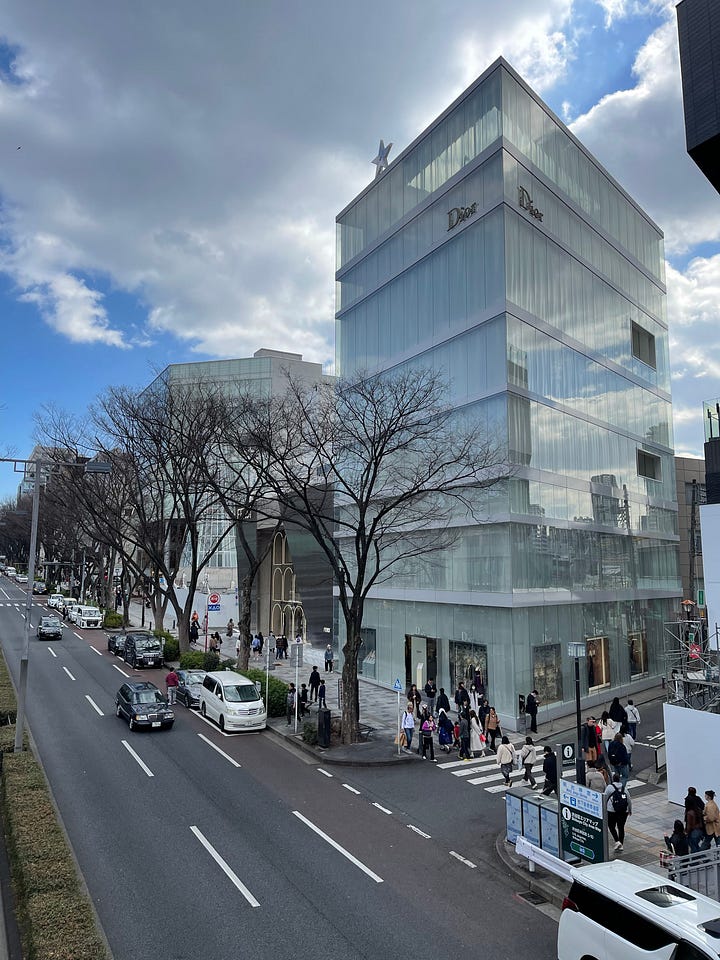
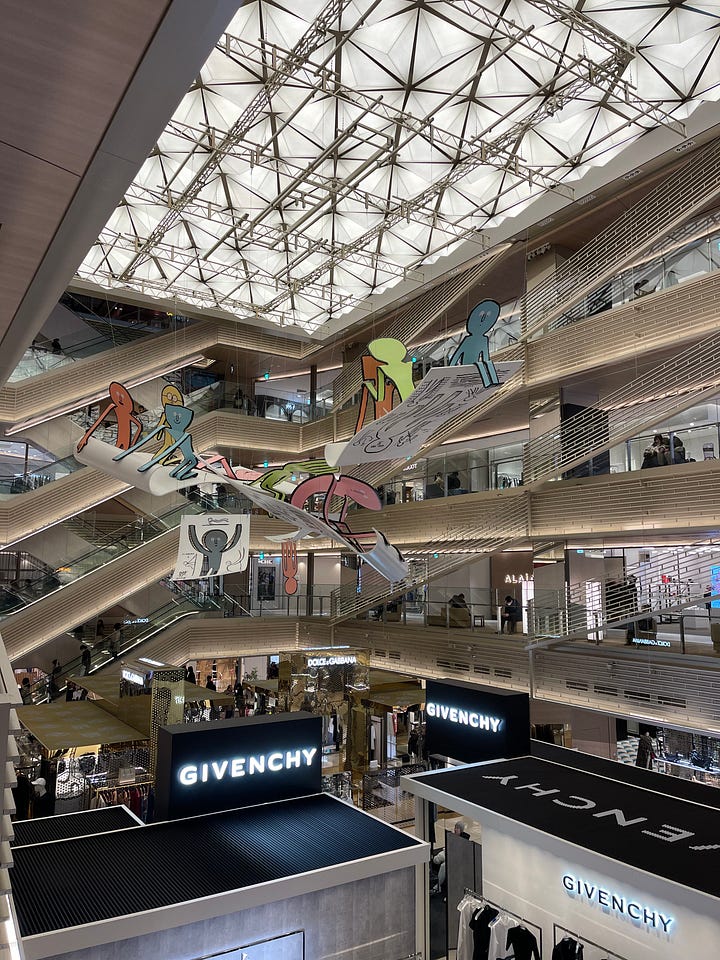
Where to Shop
Beams: Local fashion brand, kind of like a cooler and better quality Japanese version of J.Crew with slightly edgy classics.
United Arrows: Curated high-end brands for both male and female fashion, with some obscure, local labels and others more known.
Loop Wheeler: The highest quality sweatshirts in the world are made here. They’ve done collaborations with your favorite brands like Nike, Levi’s, Herman Miller furniture, etc.
Ginza Six: If you’re looking for all the luxury designers, you’ll find them (and maybe discover a few new ones) at this high-end department store in Ginza.
Laforet Harajuku: This is where the cool kids shop. It’s a department store with all the latest trends and bizarre styles.
Shibuya Parco and Shibuya 109: these indoor malls have multiple floors filled with small shops that you can get lost in for hours. Parco is a bit more trendy and edgy, while 109 is where the you’ll really get a glimpse of local fashion that skews a bit younger.
Brand Collect: Japan is one of the top markets for vintage wear, and this one has multiple locations in Tokyo.
Wander around Harajuku, Ginza, and/or Omotesando Hills to explore and see how different the shopping scene is there. You can find all kinds of random boutiques on alleyways and side streets. Takeshita Street in Harajuku is most famous, though it’s gotten a bit touristy still can be fun to take in all the craziness.
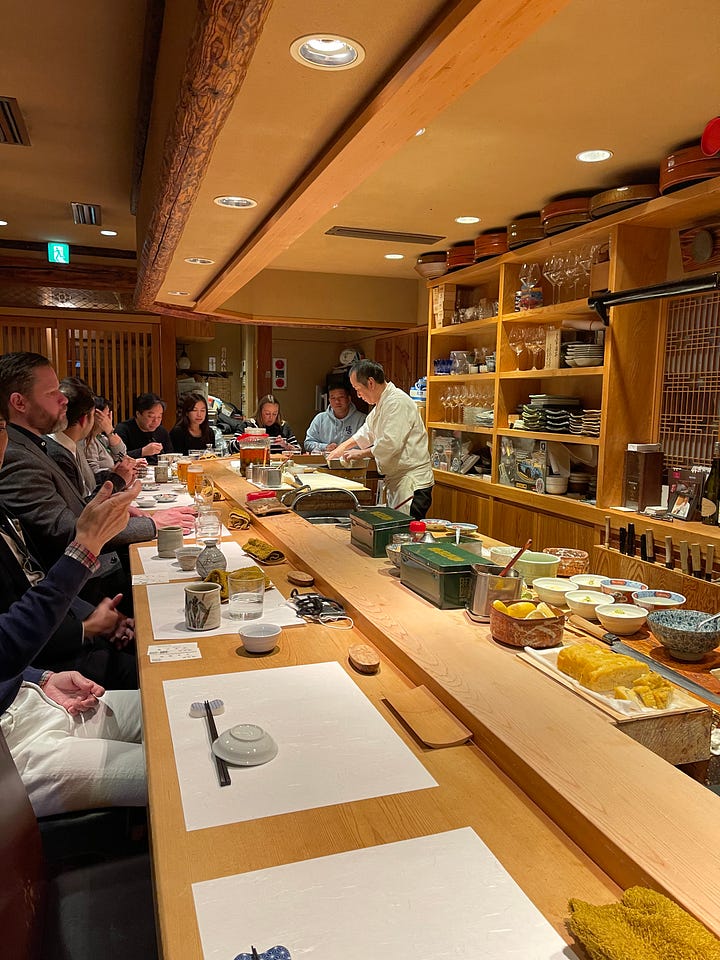
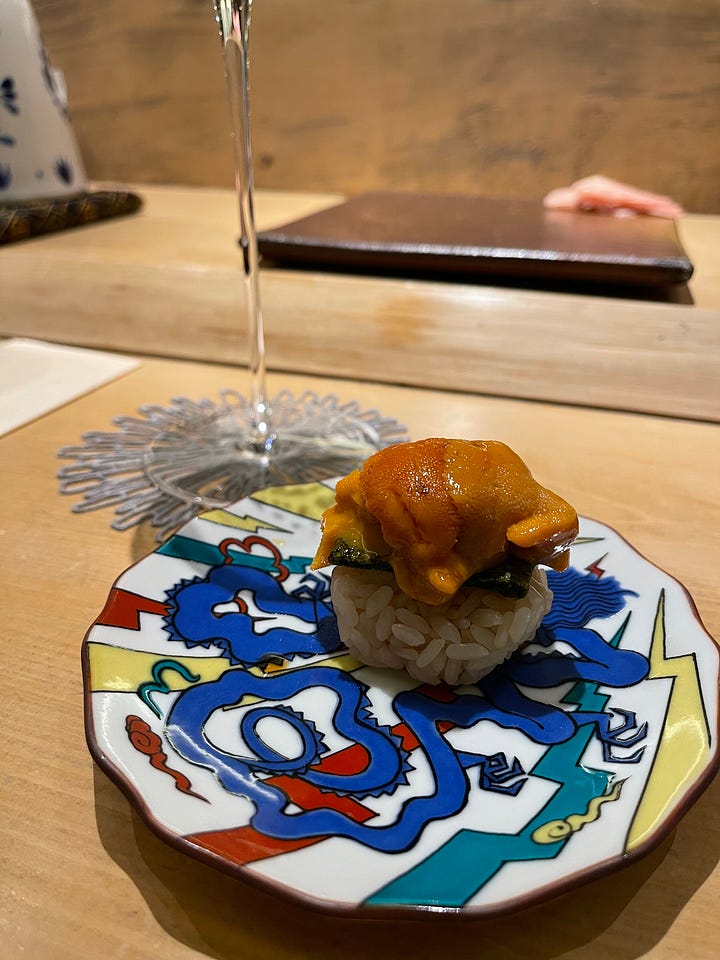
Where to Eat
The food game in Tokyo is so strong that it is the city with the most Michelin star restaurants of anywhere in the world. But don’t let this overwhelm you. The honest truth is that you can have incredible meals here without breaking the bank or trying to get on a reservation waitlist for months. Part of the fun in a city like this is that, if you’re adventurous enough, you can stumble upon just about any random restaurant, and you won’t have a bad meal. Some of our favorite meals of this trip were hole-in-the-wall places that we didn’t know the names of and the staff barely spoke any English. That said, if you want to research and bookmark some great spots, here’s our list.
Sushi
Tsukiji Itadori Bekkan: If you want the absolute freshest sushi of your life, you will want to get up early (or go straight after you arrive off the red eye) and head to the Tsukiji fish market for a sushi breakfast at 7am right when they receive the shipment for the day. Any of the counters around there will be great, but we managed to find this one which was on our list and simply outstanding.
Sushi Yuu: For a traditional sushi omakase, Sushi Yuu is legit. It has a slightly hidden entrance with no English signage and serves a wonderfully long meal where each bite is better than the last. And just when you think it can’t get any better, Chef Yuu ends the meal by sharing a taste of his mother’s homemade moonshine equivalent with you to aid with digestion. We left this one very full and beyond satisfied (unlike some sushi omakase places back home).
Udatsu Sushi: If you’re into a more modern sushi omakase experience, book Udatsu Sushi. It’s in a small neighborhood off a quiet street and has a modern design aesthetic, creative appetizers before getting into the nigiri, and the drink pairing experience was definitely not traditional. Each course had a different beverage pairing that was perfect for the flavors, but it wasn’t all sake either, meaning we had a nice buzz by the end. We won’t spoil it for you, but this is a special place.
Nemuro Hanamaru: We didn’t get a chance to go, but if you want to crush plates of sushi that come around on a conveyor belt, this is one of the recommended places to do it.
Den: We didn’t go here, but it’s supposed to be one of the very best in the city with two Michelin stars, so you’ll have to book well in advance.
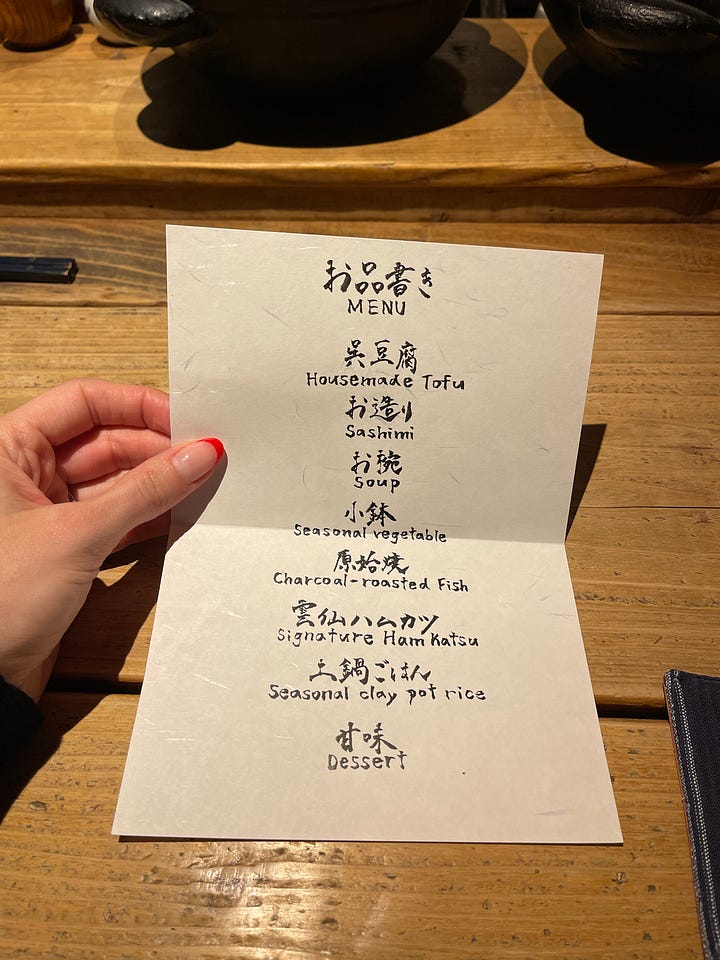

Other Japanese
In Japan, most restaurants are like small shops and specialize in one type of cooking style or Japanese cuisine. It’s not common to have a restaurant where you can get ramen, sushi and grilled meats, because their culture emphasizes honing one’s craft to perfection.
Sowado: This was a lively and awesome experience of a slightly more elegant and intimate izakaya (Japanese pub). Book a counter seat to watch all the action from the open kitchen and interact with the friendly staff. We did a tasting menu that gave us a bit of everything from cold sashimi to the fire-grilled dishes they’re known for.
Yakiniku Washino: There are plenty of places in the city to try Yakiniku (Japanese barbecue), where you cook the meat yourself on a small grill in the middle of the table. This place was in Shinjuku and had plenty of wagyu and kobe beef options to upgrade. We also tried a few pieces of wagyu sushi that were perfection.
Ryan: If you want soba noodles, Ryan is a nice place to go for it. Casual with a touch of sophistication, this was a great lunch stop that had a variety of hot and cold soba noodles, along with a specialty craft beer that’s brewed just for them.
Fujimoto: Shout out to my amazing partner who saved this place in our Google Maps after we ate there, or it would’ve been lost forever. This is one of the aforementioned hole-in-the-wall places we found for unagi - freshwater barbecued eel. It’s a delicacy in Japan, and you have to find dedicated shops that specialize in serving only this. Fujimoto is one such place, tiny and authentic, run by the chef with menus that have pictures. To note: the restroom is a Japanese squat toilet.
Harajuku Gyozaru: After some shopping in Omotesando Hills, we found this gyoza place that had a short wait. It’s smoky inside with all the pan frying and a bit chaotic - definitely giving off a ‘fast casual’ vibe, but that’s part of the charm. It’s basically amazing street food served in a place where you can sit down and have a beer.
Grill Bon Ginza: They were closed the day we tried to go, but they’re supposed to have an amazing wagyu sando. I was crushed that we didn’t get to try it, so it’s always good to check hours of operation in Google because Japan has a lot of random holidays and public closures.
7-Eleven: If you haven’t been to Japan before, hopefully you’ve heard that the 7-Elevens are way different than the ones in the States. They are ubiquitous and on another caliber, like most things in Japan. The food they have premade to-go is actually really good. Be sure to stop by one to find some unique snacks to try.

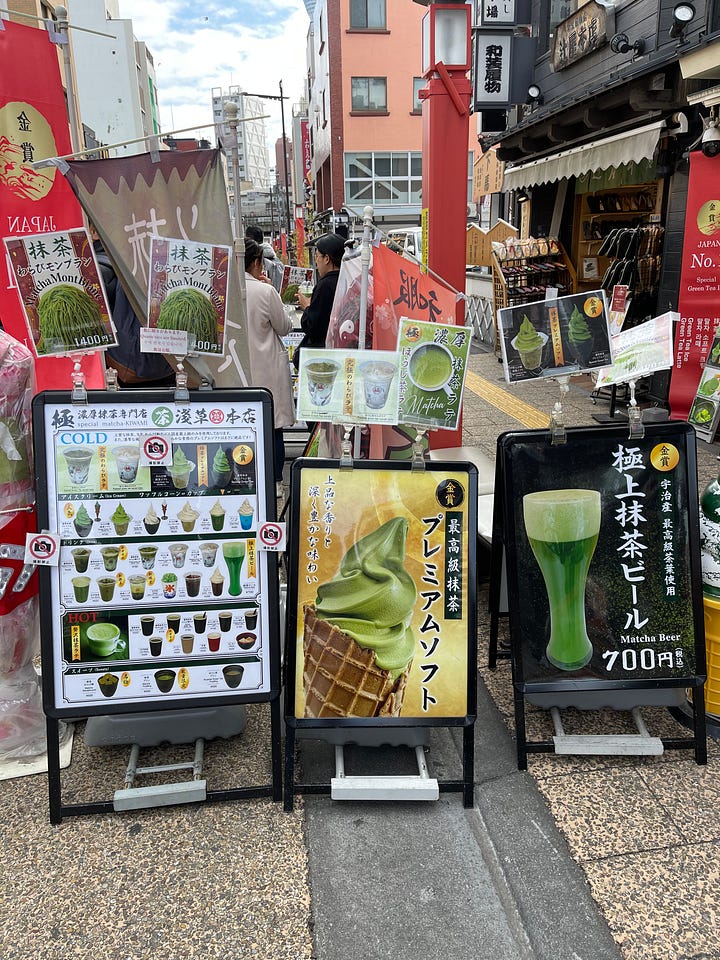
Where to Drink
Coffee & Tea
Japan takes craft coffee to a whole new level. And if you’re a tea drinker, you’re in for a real treat. Be sure to try matcha beer wherever you get the chance.
Onibus Coffee: Cozy coffee shop/window that can get crowded on a nice day.
Fuglen: Around the corner from Trunk Hotel Yoyogi Park. Scandinavian coffee and pastry spot. It also gets busy at night when it doubles as a cocktail bar.
Cafe Rostro: Also near the Trunk Hotel in Shibuya, this is a great little breakfast bar and coffee spot that sells their own beans and has a quaint vibe.
Koffee Mameya: This is like a mad scientist lab for coffee connoisseurs. Wasn’t able to go this time but at the top of our list for next time.
%Arabica: Local craft coffee chain that is like a nicer and better version of Blue Bottle Coffee.
Afternoon Tea at Aman Tokyo: Afternoon Tea is a very popular ritual. If you want to live like a fancy local, the Aman does it beautifully with a variety of intricate sweet and savory snacks to accompany your tea or champagne.

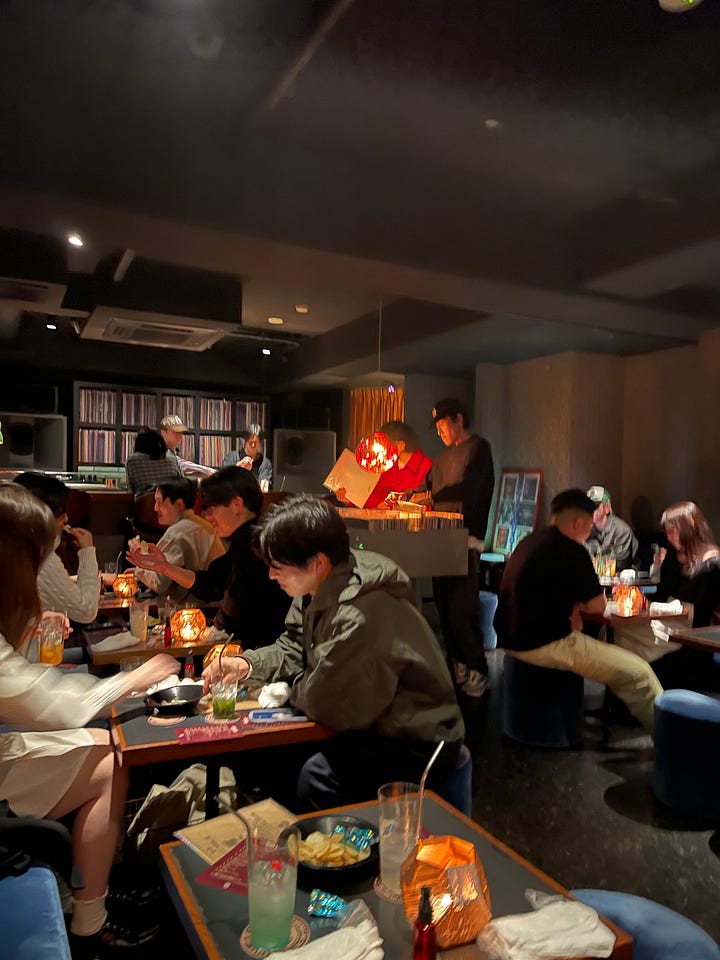
Cocktails
The cocktail scene in Tokyo is really creative. Some places are quirky and have themes, while others take their craft more seriously. Flavors can skew a bit on the sweeter side here, and whiskey is the predominant spirit of choice.
Analog Record Bar: A speakeasy with a vinyl collection in the middle of the lounge. This is probably the only place I’ve been where you not only can make a request to the DJ, it’s encouraged. Each person gets one wooden token to go crate digging and find their record of choice to take up to the booth.
Gold Bar at The Tokyo Edition Toranomon: This is an award-winning cocktail bar at one of the coolest hotels in town. You might even run into someone like Diplo. And keep an eye out for the Japanese woman who goes by “Mama” and runs the show.
Bar Amber: We found this place because it was walking distance to a dinner reservation. The cocktails were great and very unique glassware, and it was here that we first experienced a DIY Negroni with dice.
Gen Yamamoto: This cocktail omakase was not easy to book (or find), but it’s a unique and very intimate experience. No music or fancy decor, just the purity of Mr. Yamamoto putting his precision into every sip you take with interesting and obscure spirits.
Bar Benfiddich: We ran out of time to make it here, but Bar Benfiddich is doing some incredible things in the cocktail scene and deserves to be in your list as well.
Twelv: An invite-only sake tasting bar that is supposed to be a great experience. Just message them on IG for details. Sadly the owner was traveling when we were there.
Big Echo Karaoke: This isn’t a cocktail bar, but when in Tokyo, you must try karaoke at some point, and Big Echo is one of the better known places with multiple locations around the city. Order snacks and drinks to your karaoke room via iPad and sing your hearts out as long as you want.
Where to Stay
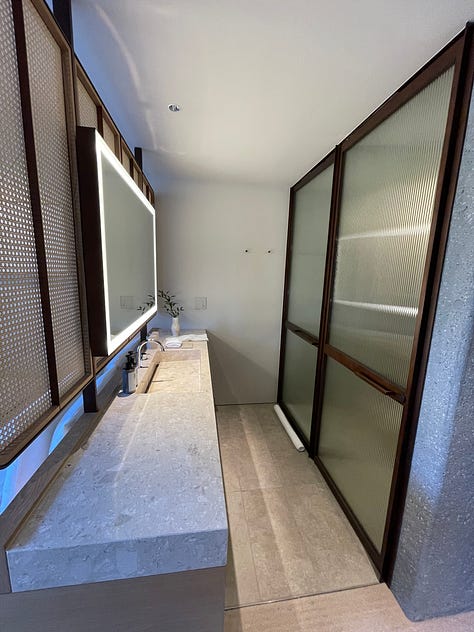

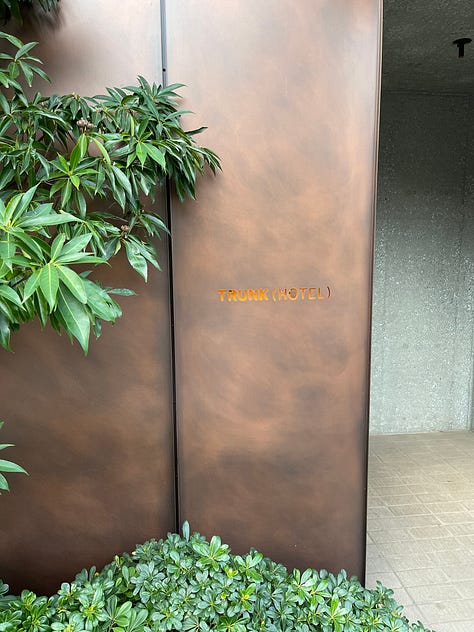
Trunk Hotel - Yoyogi Park: rates from $513, depending on season
This is the more recently opened Trunk Hotel in Shibuya. Their first location that became quite popular is on Cat Street in Harajuku. The location was great for walking to cute cafes nearby and shopping. It’s in a nice and quiet neighborhood that is close to the action when you want it.
Being right across from Yoyogi Park, this hotel definitely is more of a pocket of calm amidst the bustling city. Some rooms have lush views of the park across the street, and the rooftop pool is unique.
Designophiles will want to stay here. You feel the essence of this Japanese boutique brand with the thoughtful design of every detail. From the bathroom vanity organizers and amenities to the custom ceramicware, it is a beautiful expression of “Japandi” style. We also enjoyed the nice touches like the pajamas they put on the bed at turndown.
Standard rooms are on the smaller side and can be a bit tight on space, but for a few nights it was fine since we were out of the room exploring most of the time anyway. If this was your home base for a week or more, I’d suggest upgrading to a suite.
They have an Italian restaurant on the ground floor that also serves food on the rooftop. While we didn’t get to enjoy the rooftop pool since it was winter, we enjoyed sitting at the bar for comforting pasta and pizza to help with jet lag. The friendly expat bartender chatted with us and was very accommodating.

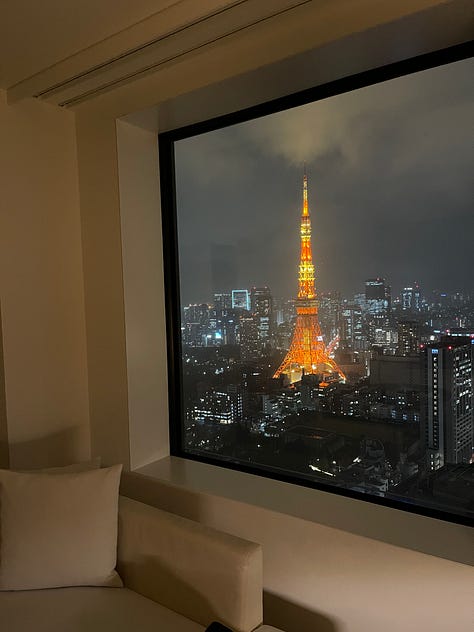
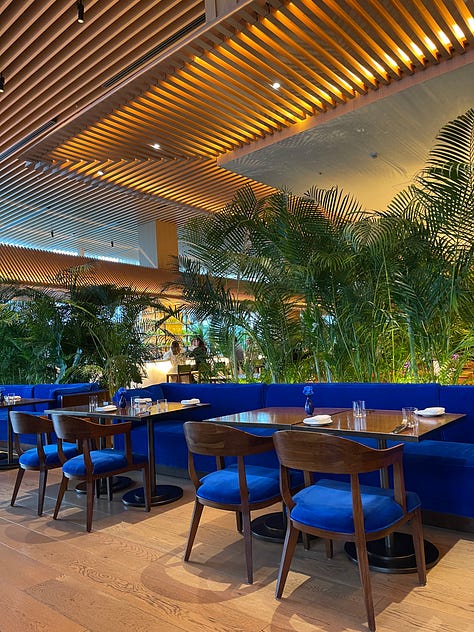
Tokyo Edition - Toranomon: rates from $797, depending on season
The location is very central - you are steps from main subway stations and walking distance to Tokyo Tower, as well as other exciting neighborhoods. This also means the hotels has impressive views of Tokyo Tower from the lobby and restaurants as well as the rooms. There are two Edition hotels in Tokyo - the other in Ginza opened more recently.
This hotel in general has a very cool and trendy vibe, not just from the design which is fun and engaging, but also the buzzing energy and the people in it. In-the-know locals come here and travelers are young families and creative types who value modern luxury over the traditional kind.
Stay here if you want a hotel that is part of the action and a destination itself - we had breakfasts with a view of Tokyo Tower and ended our trip with a memorable night at the Gold Bar as mentioned above. The restaurants and bars are upscale but have a fun energy with the bold colors and design choices. We didn’t get to check out the spa.
We booked through AmEx and got a room upgrade with a view. The hotel rates here can get pricey, but it’s worth it for rooms that are spacious by Tokyo standards, have a striking yet minimal design and are very comfortable. Honestly no complaints about the room or the overall stay, although our room was a bit of a walk from the elevators and the hallway walls could use a fresh coat of paint.
Getting Around Town
Trains & Subways
If you can navigate the subway in NYC, London, or any other major city, you can do it in Tokyo too.
Tokyo’s subway system is vast but well-organized, with JR East lines (including the circular Yamanote Line) and private subway systems like Tokyo Metro and Toei Subway. The Suica and PASMO IC cards are essential for seamless travel across all lines, and they can also be used for buses, vending machines, and even convenience stores. They easily work with Apple wallet for tap and go. Announcements are made in Japanese and English, but you have to listen closely to hear them. There’s an observed quietness, so be sure to use headphones and speak quietly to respect the culture.
Pro Tip: Google Maps is great for navigation, but the Navitime or Tokyo Subway Navigation apps are even more precise when planning routes.
Peak Hours Warning: Trains are notoriously packed during rush hours (7:30–9:30 AM & 5:00–7:30 PM), so try to avoid traveling then if possible.
Airport Transfers: The Narita Express (N’EX) and Keisei Skyliner offer direct routes from Narita Airport, while the Tokyo Monorail and Keikyu Line connect Haneda Airport to the city.
Taxis & Ride-Sharing
Taxis in Tokyo are clean, safe, and reliable but expensive. They literally offer white glove service, and many have seat warmers on for the winter months. The doors open automatically (don’t try to open them yourself!), and most drivers use a meter. Some taxi drivers speak English, but it's helpful to show your destination in Japanese on your phone. Otherwise your hotel can usually assist with communicating this on your behalf when departing.
If you miss the last train (usually around midnight), taxis become the best option—though fares increase significantly after 10 PM.
Uber is available but also can add up, though it simplifies things with trying to communicate your destination.
For most people, the train system will be the primary way to get around, but taxis can be useful for shorter distances or late-night rides.
Have you been to any of these places in Tokyo or are you planning a trip there? Let us know in the comments!









